Why Elusive Buffalo Milk Cheeses Are Worth Hunting Down
Rich and savory, buffalo milk makes luscious yogurt, cheese, and butter.
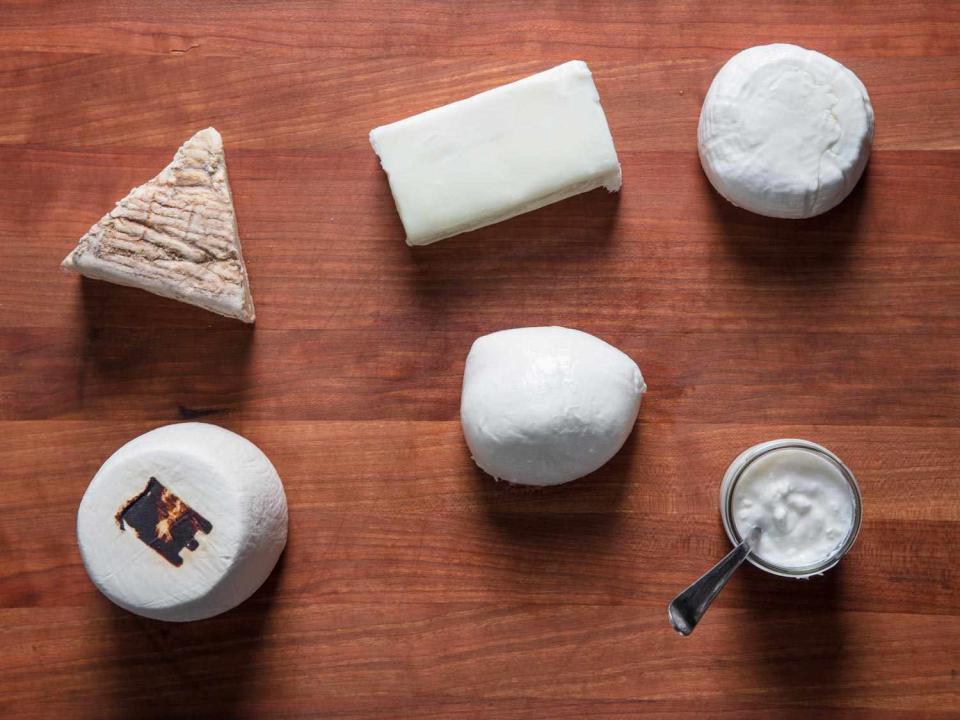
Serious Eats / Vicky Wasik
One Friday morning in May, many years back, I was working at Wasik's Cheese Shop in Wellesley, Massachusetts, when one of the proprietors' sons, Brian, came barreling behind the counter with a flat cardboard crate. He pulled back the lid to reveal six squat plastic tubs of stracciatella di bufala, then grabbed a knife and sliced back the wrapping from one of them, giddy as a kid on Christmas morning. Brian reached into the nearby basket of baguettes, tore off a piece, and used it to scoop into the container of slippery white curds. He rifled through the tray of sample products behind the counter for a bottle of olive oil and a box of flaky salt, garnished the stracciatella with both, and, with all the kindness and generosity in the world, handed me that perfect first bite.
I'm an avowed cheese fanatic who has been in and out of the business for years—I've worked as a cheesemonger, managed cheese menus at restaurants, designed an artisan-cheese program at a boutique grocery store, visited domestic dairy farms and Alpine aging caves, and I now dabble in writing about my favorite fromage. I've long understood that water buffalo milk cheese is something special. Even in the parts of the country where you can get just about anything, buffalo milk products are rarely available, often expensive, particularly perishable, and precious. They're the type of thing that made my cheese mentors' eyes shine and well up with enthusiasm—more at the opportunity to eat the stuff than to sell it, really. But I never much thought to ask why it's such a rare treat.
Most Americans who have heard of buffalo milk know it by way of Italian mozzarella di bufala. This especially soft mozz is worlds apart from rubbery, low-moisture grocery store shreds, and is moister, richer, and more tender even than the cow milk fresh mozzarella layered in the Caprese salads of thousands of Italian restaurants around the world. In his 2012 New York Times Magazine profile of the late water buffalo farmer Craig Ramini, Sam Anderson describes real mozzarella di bufala as "the apotheosis of dairy: the golden mean between yogurt and custard and cottage cheese and heavy cream and ricotta."
What Makes Buffalo Milk Cheese Special
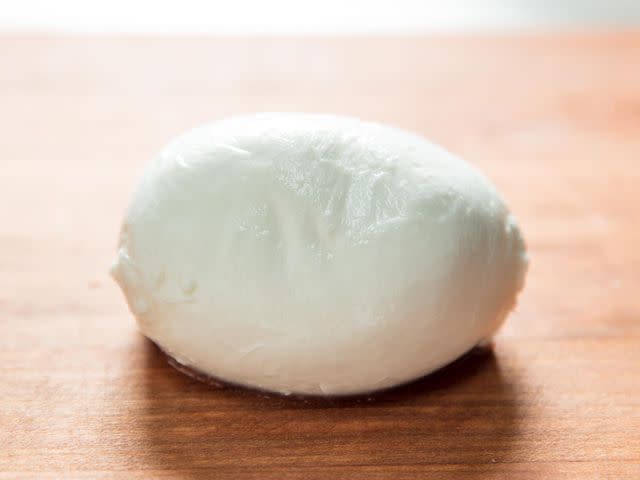
Serious Eats / Vicky Wasik
In Italy, mozzarella always refers to the buffalo milk product, while the dense, chewier cow's milk version we often see here in the United States is known as fiore di latte. Most of this "fresh" cow's milk mozzarella, whether American or Italian, has a firmer texture that holds up well and stays sliceable and solid, even after a couple of weeks in the fridge. Aaron Foster of Foster Sundry in Brooklyn explains that "most fresh cow's milk mozzarella is made from premade curd, and so it's already sort of lost that freshness." Buffalo milk cheeses, on the other hand, are highly perishable even compared to other unaged cheeses; they lose their sweet-tart-yeasty freshness rapidly, their textures begin to break down after about a week, and they quickly take on an unpleasant sourness. This is why most mozzarella in Italy is sold and consumed just a day or two after it's made.
Imported mozzarella di bufala has made inroads into American markets, and the US has begun to see more and more burrata made of buffalo milk as well: thin sacks of mozzarella, stretched around a soupy filling of those same creamy shreds of tough-to-find stracciatella—a mixture of shaggy shreds of mozzarella and thick cream—that Brian Wasik fed me years ago. Yet even in America's food epicenters, these fresh products can be tough to find. And, while I've encountered some excellent producers of fresh cow milk mozzarella in the US, I'd never come across a domestic mozzarella di bufala before researching this article.
The Complexities of Making a Domestic Buffalo Cheese
Anderson refers to mozzarella di bufala as "the Great White Whale of American cheesemaking: a dream so exotic and powerful that it drives otherwise sensible people into ruinous monomaniacal quests." I've recently come to realize the truth in that assessment. In the early 2000s, a small farm in Vermont, Woodstock Water Buffalo Company, began nationally distributing a fantastic buffalo milk yogurt. It was mildly flavored and rich, with a nearly sliceable texture, somewhere between cream cheese and mousse. The flavored versions were lightly sweet and subtle; the plain was a rich, tart, and yeasty neutral dairy ingredient, perfect for tzatziki, raita, and baking. When I tried to track down Woodstock's products again, I learned that the yogurt was no longer being produced, that the original owners had sold the farm, and that the location had ceased operating as a buffalo dairy.
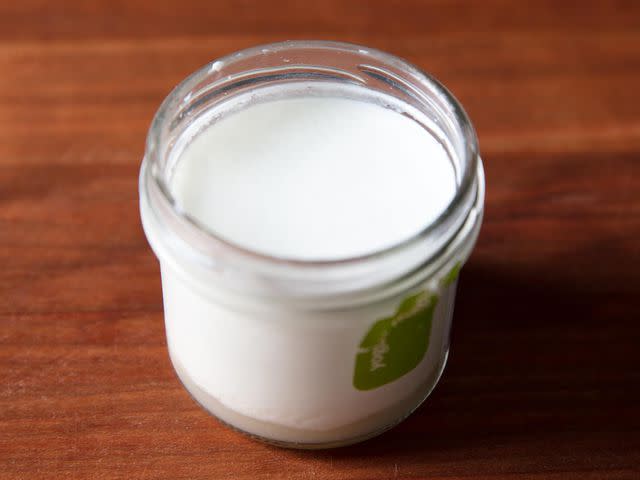
Serious Eats / Vicky Wasik
There are a handful of very small water buffalo farms operating domestically. After his abrupt passing in 2015, Craig Ramini's widow, Audrey Hitchcock, took over his beloved herd, but distribution of Ramini Mozzarella remains limited to a handful of restaurants in the Bay Area. Riverine Ranch in New Jersey raises water buffalo for both meat and milk and even produces some non-European items, like paneer and labneh, but these are available at only a handful of farmers' markets in New York. Ithaca Water Buffalo Farm produces a few varieties of plain and flavored yogurt, but its distribution, too, is limited to the Northeast. These small farms are all outliers, and no North American water buffalo dairies have achieved the broad distribution that Woodstock once had. Anderson's 2012 article gave a bleak prognosis for the industry, noting that "over the last 15 years...the attempt to make authentic buffalo mozzarella—to nail both its taste and texture—has destroyed businesses from Vermont to Los Angeles. It seems truly doomed."
Why is it such a challenge to raise these elusive animals here? Part of the answer relates to climate. Despite American lore, buffalo are not native to the US, where the animals that we colloquially call "buffalo" are in fact bison. Water buffalo most likely originated in Asia and were spread through India, North Africa, and Italy as meat and dairy animals. They are the primary source of dairy in parts of Africa and in India, where buffalo milk is consumed fresh and used to make paneer, yogurt, and ghee. Buffalo are also strong draft animals, prized for clearing overgrown jungle and forest for farming. Herds of water buffalo were introduced to the Caribbean, and eventually brought to South America in the mid-20th century, to clear and till farmland for the palm oil industry.
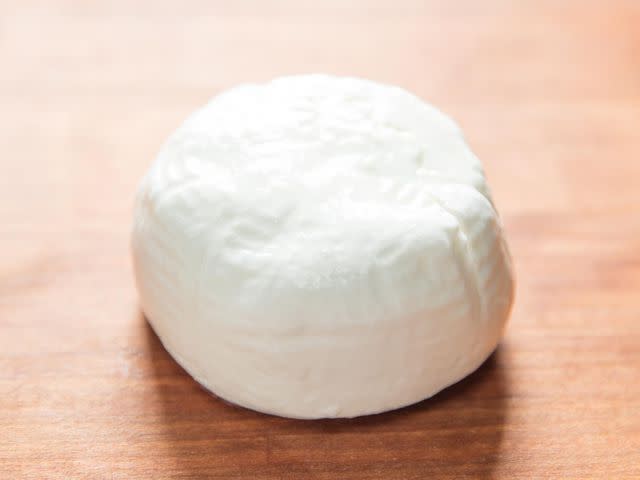
Serious Eats / Vicky Wasik
In fact, it is in South America that we find some hope for New World buffalo farming. Alejandro Gomez Torres, cofounder of Buf Creamery in Colombia, grew up well-acquainted with water buffalo as work animals. While managing a farm that raised male water buffalo for the local palm oil industry, Torres found himself with a unique problem that he describes as "too many buffalo." At a dinner party, a few of his friends suggested he start a cheese business using their rich milk, and, "obviously," the jovial entrepreneur told me, "after a couple glasses of wine, anything is possible."
As it turns out, the consistently temperate, rainy climate of the Andes is a great deal like that of Campania, the birthplace of mozzarella di bufala, and Torres's animals grow healthy and strong on the grassy mountain pastures. They live outdoors their whole lives, and, though each produces only about a gallon and a quarter of milk per day—much less than a cow's average of seven to eight gallons—Torres explains that they are still "very efficient for the area, because cows do not do well in these areas. They die, where buffalo can thrive," thanks to the latter's affinity for high-rainfall zones similar to those of their ancestral home.
Torres promptly traveled to Italy to study the mozzarella-making process, brought back several pieces of Italian machinery—including a pasteurizer, fermenting vats, and stretching and molding machines—and quickly set to work on his recipe. His herd's all-grass diet presented significant challenges at first, as animals raised on pasture incidentally consume more water than grain-fed animals, translating to more water in the milk. (Most Italian farmers keep their buffalo indoors and raise them on a highly efficient, nutrient-dense diet of grain, which produces a more concentrated milk.) Initially, traditional Italian mozzarella-making techniques did not work with this grass-fed milk, but Torres eventually solved the problem by pasturing his two herds on opposite sides of a mountain. By blending the herds' milk, which differed due to varying rainfall on the two pastures, he was able to create a consistent product.
In addition to climate issues and low milk yield, another huge challenge facing North American buffalo farmers is the psychology of the animals. Water buffalo are notoriously nervous, untrusting, and resistant to mechanical milking. Buf Creamery addresses this by structuring its daily milking routine to relax and comfort the buffalo as much as possible. The process starts with a shower for each animal (!), followed by a very slow and gentle mechanical milking, and finishes with some time for them to nurse their own calves. Torres compares the routine to "therapy" or a "spa day" for the herd. In the US, all that extra time, labor, and feed for a low-yield animal, along with the boutique nature of the product, makes for far lower profit margins than cow-based dairy farming.
Different Types of Buffalo Milk Products
Aged Cheeses
Nutritionally, water buffalo milk is higher in fat, calcium, iron, and phosphorus than cow's milk, and it contains approximately 11% more protein. However, while buffalo milk has slightly nuttier, more acidic notes, the two are not wildly different in flavor; the most noticeable distinguishing feature of buffalo milk is textural. Aging and ripening—often used to add value to funkier-flavored milks, such as goat's and sheep's milk—don't make a lot of sense for buffalo milk, as aging processes tend to distort its texture, thus sacrificing its unique tenderness and creaminess.
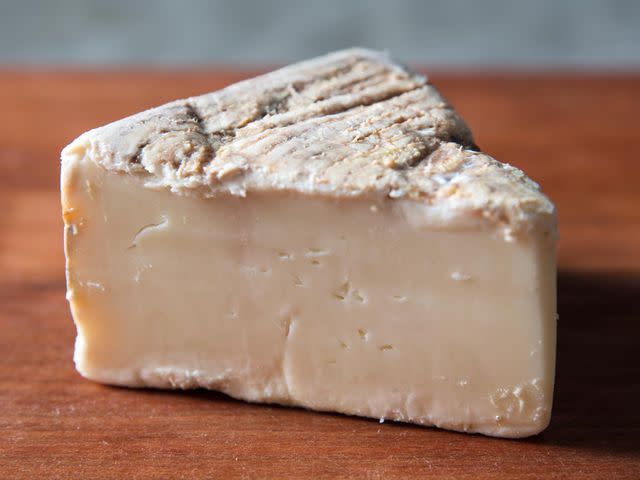
Serious Eats / Vicky Wasik
The primary benefit of aging is that it extends the cheese's lifespan, a relatively weak selling point for cheese-makers struggling to justify the added cost of something that could easily be mistaken for a cow's milk product. As Foster explains, "buffalo milk cheeses, especially aged ones, do tend to be milder...they're fattier, and the flavor of buffalo milk itself is fairly mild compared to goat and sheep's milk. This makes sense—buffalo are much closer to cows than to sheep or goats." Without that distinctive "goatiness" or "sheepiness" to set them apart from aged cow milk cheeses, aged buffalo cheeses aren't readily marketable in the US. In addition, Foster continues, "there is less of a culture here [in the US] of consuming buffalo milk dairy products, so consumers aren't necessarily as willing to pay the premium. It's less that it's unknown, and more that people don't really understand the value proposition." For his part, Torres has experimented with caciocavallo, brie, and provolone recipes using Buf Creamery milk, and, while he was happy with the results, the added time and cost involved was simply too high. He chose to stick with mozzarella, burrata, and yogurt, because, he says, "We believe in adding value to the milk where it can really show and express its beauty."
If you're curious to try some aged buffalo cheese for yourself, do some digging or pester your cheesemonger, who might be able to track down a few imported versions. One Italian producer, Quattro Portoni, makes and exports a range of buffalo milk products that are occasionally available at Murray's Cheese and Eataly. One of my favorites from this producer is the small, semi-firm, tomme-like Moringhello di Bufala—it's tart, rich, and mild, with a dry edible rind and a dense, chalky, yet smooth texture. Another Quattro Portoni cheese, Bufarolo, is finished in Crown Heights, Brooklyn, at Crown Finish Caves, making it almost certainly the only aged Italian-American water buffalo cheese out there. These aged cheeses are pricey, starting at about $25 a pound, but I think it's well worth springing for a thin slice in the name of research.
Fresh Products
To get the most out of domestic and imported buffalo milk products, keep an eye out for some of the fabulous fresh cheeses that trickle into specialty shops and farmers' markets during the tomato season. My beloved stracciatella di bufala is still a bit of a unicorn, but its cousin, burrata di bufala, is getting easier to find, and imported mozzarella di bufala is increasingly available at good grocery stores. I'm fond of Antiche Bontà from Campania, as well as Buf's version, which is now available at Whole Foods. Buf is also working to introduce its yogurt to the North American market, and possibly (hopefully!) an eventual ice cream.
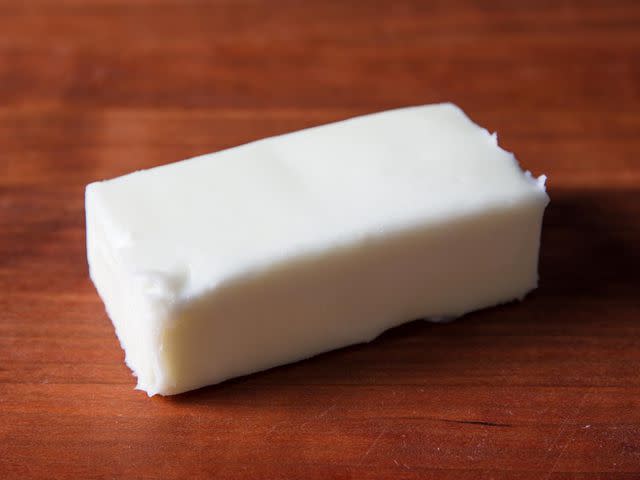
Serious Eats / Vicky Wasik
A few Italian brands of buffalo butter pop up now and then; I like a brand called Delitia. Italian cultured butter generally tends to be milder and less "cheesy" in taste than French styles, and I've found that the buffalo versions fall flat on flavorful crusty bread—their mellow, nutty notes are better suited to melting over steamed asparagus or wax beans, with a sprinkling of flaky salt. The Italian company Casa Madaio exports a range of aged and fresh buffalo milk products to the States that are beautifully packaged (with price tags to match!). Madaio's "semi-mature" ricotta salata is a dense, rich, and chewy white cake of a cheese that would be equally impressive at the center of a brunch or a dessert, with sweet or savory accompaniments. And its rich, whole-milk lemon yogurt, packed in tiny glass jars with a dollop of bittersweet lemon marmalade on the bottom, is one of the best simple desserts I've eaten all year.
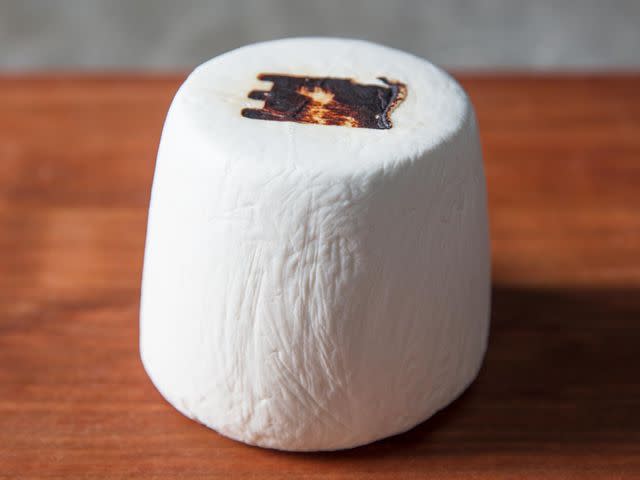
Serious Eats / Vicky Wasik
In the United States, buffalo products like these are likely to remain novelties, so any cheese lover who finds imported styles at their local grocery should snatch them up. And, if you come across any American versions at your farmers' market, remember that raising water buffalo here is a tough business. These products will be expensive, and they will be worth it; buy them, tell your friends to buy them, and thank your local buffalo farmer.
June 2017
Read the original article on Serious Eats.

